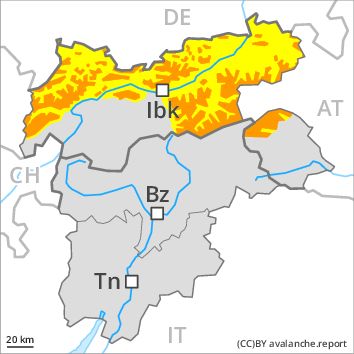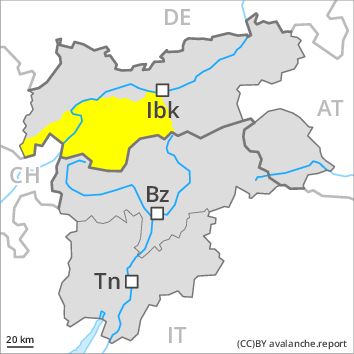Regions
Western Verwall Mountains, Eastern Verwall Mountains, Northern Zillertal Alps, Allgäu Alps, Venediger Range, Eastern Lechtal Alps - Ammergau Alps, Mieming Mountains, Western Tuxer Alps, Karwendel Mountains, Eastern Tuxer Alps, Brandenberg Alps, Western Kitzbühel Alps, Wilder Kaiser Mountains - Waidring Alps, Eastern Kitzbühel Alps, Western Lechtal Alps, Central Lechtal Alps, Grieskogel Mountains

Danger level
Danger Level 3 - Considerable above the treeline
Danger Level 2 - Moderate above the treeline
Avalanche Problem
Wind-drifted snow above the treeline, N-NE-E-W-NW

Fresh wind slabs represent the main danger.
The snow sport conditions outside marked and open pistes are to some extent precarious. The avalanche prone locations are to be found in particular on west to north to east facing wind-loaded slopes. In some cases avalanches are medium-sized and can be released easily even by a single winter sport participant. The number and size of avalanche prone locations will increase with altitude. As the day progresses, individual natural avalanches are possible, in the regions exposed to a lot of wind especially on steep shady slopes. Extensive experience in the assessment of avalanche danger is required.
Dry avalanches can in very isolated cases be released in the old snowpack, mostly by large additional loads, in particular on very steep shady slopes. Transitions from a shallow to a deep snowpack are unfavourable.
In addition a latent danger of gliding avalanches exists.
Snowpack
dp 6: cold, loose snow and wind
dp 5: snowfall after a long period of cold
In some regions 15 to 20 cm of snow. fell. The sometimes strong wind will transport the fresh snow. Over a wide area wind slabs are lying on old snow containing large grains, in particular on shady slopes. It is lying on surface hoar in some places on shady slopes at low and intermediate altitudes.
The somewhat older wind slabs have bonded quite well with the old snowpack. Faceted weak layers exist deeper in the old snowpack in particular in areas where the snow cover is rather shallow, especially on very steep shady slopes.
Tendency
The avalanche danger will persist. Slight increase in danger of gliding avalanches and moist snow slides in particular on steep sunny slopes.
Regions
Glockturm Range, Weißkugel Range, Gurgler Range, Central Stubai Alps, Silvretta, Samnaun Mountains, Northern Oetz and Stubai Alps

Danger level
Danger Level 2 - Moderate above the treeline
Danger Level 2 - Moderate above the treeline
Avalanche Problem
Wind-drifted snow above the treeline, N-NE-NW

Fresh wind slabs represent the main danger.
Fresh wind slabs are to be evaluated with care and prudence. The avalanche prone locations are to be found in particular in northwest to north to northeast facing aspects. Avalanches are rather small but can be released easily by a single winter sport participant. The number and size of avalanche prone locations will increase with altitude. Experience in the assessment of avalanche danger is required.
Dry avalanches can in very isolated cases be released in the old snowpack, mostly by large additional loads, in particular on very steep shady slopes. Transitions from a shallow to a deep snowpack are unfavourable.
In addition a latent danger of gliding avalanches exists.
Snowpack
dp 6: cold, loose snow and wind
dp 5: snowfall after a long period of cold
In some regions 5 to 10 cm of snow. fell. The sometimes strong wind will transport the fresh snow. Over a wide area wind slabs are lying on old snow containing large grains, in particular on shady slopes. It is lying on surface hoar in some places on shady slopes at low and intermediate altitudes.
The somewhat older wind slabs have bonded quite well with the old snowpack. Faceted weak layers exist deeper in the old snowpack in particular in areas where the snow cover is rather shallow, especially on very steep shady slopes.
Tendency
The avalanche danger will persist. Slight increase in danger of gliding avalanches and moist snow slides in particular on steep sunny slopes.
Regions
Glockner Range, Eastern Deferegger Alps, Schober Mountains, Lienzer Dolomites, Eastern Rieserferner Mountains

Danger level
Danger Level 2 - Moderate above the treeline
Danger Level 1 - Low above the treeline
Avalanche Problem
Wind-drifted snow above the treeline, N-NE-NW

Fresh wind slabs require caution.
Fresh wind slabs represent the main danger. The avalanche prone locations are to be found in particular in northwest to north to northeast facing aspects. The wind slabs are rather small but in some cases prone to triggering. The number and size of avalanche prone locations will increase with altitude. Experience in the assessment of avalanche danger is required.
Dry avalanches can in very isolated cases be released in the old snowpack, mostly by large additional loads, in particular on very steep shady slopes. Transitions from a shallow to a deep snowpack are unfavourable.
In addition a latent danger of gliding avalanches exists.
Snowpack
dp 6: cold, loose snow and wind
The sometimes storm force wind will transport the old snow. In some cases wind slabs are lying on old snow containing large grains, in particular on shady slopes. It is lying on surface hoar in some places on shady slopes at low and intermediate altitudes.
The somewhat older wind slabs have bonded quite well with the old snowpack. Faceted weak layers exist deeper in the old snowpack in particular in areas where the snow cover is rather shallow, especially on very steep shady slopes.
Tendency
The avalanche danger will persist. Slight increase in danger of gliding avalanches and moist snow slides in particular on steep sunny slopes.



